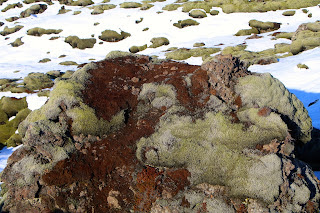The next day, we embarked upon our two-day south coast/ice cave tour. The first half of the first day repeated what we had done the day before. But, we had even better sunshine in some places and, quite frankly, that scenery just doesn’t get old.
 |
| Reynisdrangar |
Plus, because we had been the day before, we didn’t mind that the stops had to be short so that we could make it to our destination.
 |
| Good tour |
The tour was with Extreme Iceland and our tour guide, Vignir, was fabulous. He was very accommodating, but firm about keeping us on schedule.
He was very knowledgeable – even helping me ID Northern Fulmars as the birds nesting on the cliffs.
I had been trying for over a year to identify one I had photographed when traveling with Caty.
We first drove over the mountains to the South Coast.
Vignir explained that the mountains were the edges of the tectonic plates of North America and Europe. Further south, that edge is a trough.
 |
| So gorgeous |
We stopped at Selandjafoss ...
 |
| This time, I concentrated on the Northern Fulmars instead of the waterfall |
... Skogafoss ...
With a constant flow of molten magma, 33 percent of all volcanic material on Earth and 33 percent of all of Earth's lava flows are in Iceland.
On average, an eruption occurs in Iceland every four years.
The sculptural cliffs are dotted with dramatic waterfalls.
 |
| Waterfalls are all along the coast |
... including this one that disappeared into a curving cleft that had been carved into the mountainside.
 |
| A waterfall and a rainbow |
As we traveled, we got increasingly beautiful views of Vatnajökull, which is the largest and most voluminous ice cap in Iceland and one of the largest in Europe. Its average thickness is 1,300 feet, but reaches 3,300 feet thick in some areas.
 |
| Vatnajökull |
Iceland's highest peak at 6,921 feet, Hvannadalshnúkur, is located in the southern edge of Vatnajökull. There are multiple volcanoes under the ice cap. Most of what you can see of Vatnajökull are "outlet glaciers," which each have their own names, but are part of the larger glacier.
 |
| Wide view |
The frequent eruptions and melting of the temperate glaciers causes many floods, which can wreak havoc on the roads and the bridges that span the wide braided glacial streams. This "sculpture" is actually remains of a bridge that was swept away several years ago.
 |
| Reality art |
Although we weren’t originally scheduled to stop at Jökulsárlón until the next day, we convinced Vignir to stop while the weather was good because the next day’s forecast looked dismal. Actually, it didn’t take much to convince him – I think he loves the place.
 |
| Oh my! |
Jökulsárlón is truly unique. It is a deep lagoon carved out as Vatnajökull receded. Because there is a terminal moraine at the ocean side, the lagoon traps icebergs that have calved off the glacier until the tide rises, when they then escape to sea. The most amazing thing is that the lagoon formed as recently as the 1930s, meaning the glacier has receded about a mile in less than 100 years.
The size of the lake has increased fourfold since the 1970s because of the melting of the glacier and its many subglaciers. It covers an area of about 6.9 square miles and is the deepest lake in Iceland, at over 814 feet.
 |
| Iceberg |
Jökulsárlón has been a setting for four Hollywood movies: A View to a Kill, Die Another Day, Lara Croft: Tomb Raider and Batman Begins.
We snapped a few pictures and then proceeded to out hotel, the Guesthouse Gerði at the Hali farm in Höfn. It is in the same complex as the Skyrhúsið Guesthouse, where Caty and I stayed when we went to Iceland last year. The Gerði room was nicer than both the Skyrhúsið and the Skjaldbreid, but dinner was pretty bland (at more than $50 a person) and breakfast was even more meager than the Skjaldbreid.
 |
| Home! |
By the way, food in Iceland is crazy expensive. It’s not unusual to pay $25 for a burger and fries. If you go, you can save money by eating your hotel’s breakfast (which is generally included with the room) and picking up picnic items.
We really wanted to go to Jökulsárlón that night to photograph aurora – the night was clear and spaceweather.com looked encouraging. Vignir told us he couldn’t take us because tour guides are regulated the way truck drivers and pilots are with mandatory sleep breaks, but we met two young guys with a car who gave us a ride. We returned the favor by providing aurora photography tips.
At first, we just had a beautiful moonlit view of the lagoon ..
 |
| Jökulsárlón |
... but, it didn't take long for some streaks to start appearing in the sky. While it wasn’t spectacular, we did have some aurora that was actually visible, if pale.
 |
| So-so aurora; great location |
We stayed about an hour or so before returning to the hotel. I could have stayed longer, but it wasn’t our car. I should have stayed up – I heard there was more aurora between 2:00 and 4:00.
But, we got some.
 |
| Success |
The next post will cover the rest of our trip, including the ice cave tour.
Trip date: March 5-11, 2017

































































